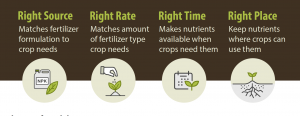4R Nutrient Stewardship is an internationally-recognized program that advocates for responsible and effective management of nutrient resources. The 4Rs stand for the Right source of fertilizer used at the Right rate, at the Right time and in the Right place. With acres counted under 4R Nutrient Stewardship, canola growers can demonstrate their commitment to improved nutrient use. Part one of the article shows how to get acres counted. Part two describes basic-level 4R practices for nitrogen and phosphorus in Western Canada.

What is 4R?
4R Nutrient Stewardship is a Fertilizer Canada framework, and the goal of the 4R designation program is to help crop producers minimize environmental concerns related to agriculture while maximizing economic benefits. The principle is simple: provide the right source of nutrients at the rate, time and place that will minimize the losses of nutrients and maximize the crop’s access to the nutrients.
Why does it matter?
Canada’s canola industry sees a lot of potential for 4R Nutrient Stewardship, especially to enhance nutrient use efficiency. Canada’s canola industry has a goal to utilize 4R Nutrient Stewardship practices on 90 per cent of canola acres by 2025.
How to get your 4R acres counted?
In many cases growers may already be going through these planning activities already, making it a simple process to adopt. To become a part of the 4R program, farmers have to work with a 4R designated agronomist. (A farmer cannot get acres counted on their own.) The agronomist helps the farmer construct a specific 4R nutrient management plan to make sure acres can be considered 4R. Once farmers have taken the steps required to complete a 4R plan, the 4R designated agronomist compiles all 4R acres, on a crop and location basis, and submits these acres to Fertilizer Canada. Fertilizer Canada never sees individual plans developed, as that stays between the agronomist and the farmer customer. All Fertilizer Canada sees is a total number of acres by location and crop. To find an designated agronomist, ask at a local inputs retailer or check the latest list at Fertilizer Canada.
What’s in it for the farmer?
Two things. First, fertilizer is the biggest expense in canola production. Through the use of 4R Nutrient Stewardship, farmers can ensure they use fertilizer efficiently and get more return from the investment. Second, end users and regulators are paying more attention to crop production practices such as how fertilizer is utilized, especially escapes to the atmosphere and runoff into waterways. Losses to the environment are monitored and could lead to regulations. With acres counted as 4R, farmers show a commitment to improved nutrient use.
Fertilizer Canada resources for agronomists who want to get their designation.
Fertilizer Canada resources for farmers, including where to find a designated agronomist
Basic nitrogen practices for 4R
Here are the basic 4R practices for nitrogen management for spring cereal, oilseed and pulse rotations on the Canadian Prairies. These are from Fertilizer Canada’s guidance tables, which you can find in a PDF here, under heading 3.
Right Source
- Ammonium-based formulations for fall (UAN excluded due to nitrate content).
- Any N fertilizer in spring or in-season.
- Inoculate pulse crops. Exception: Not required for dry beans which are typically fertilized.
…Rate
- Set crop and field specific N rates using appropriate regional tools such as nitrate soil tests (surface and subsurface sampling recommended) nitrogen balance, response curves or provincial guidelines.
- Consider field specific yield history and soil types in relation to yield potential of other fields on farm and in region, and probabilities for weather variations when setting rates
…Time
- Apply N after soil cools in fall; or
- Apply N in spring before or at seeding.
- No N application on frozen soil and/or snow covered ground.
…Place
- Apply in subsurface bands/ injection any acceptable time.
- Broadcast and incorporate in spring.
- Avoid fall broadcast of unprotected N.
- Fall broadcast of enhanced efficiency N fertilizers are acceptable following label instructions regarding incorporation and timing.
- Fall broadcast N applied as MAP or DAP with incorporation is acceptable.
Basic phosphorus practices for 4R
Here are the basic 4R practices for phosphorus management for spring cereal, oilseed and pulse rotations on the Canadian Prairies. These are from Fertilizer Canada’s guidance tables, which you can find in a PDF here, under heading 3.
Right Source
- Use P fertilizer with guaranteed analysis.
…Rate
- Use recent soil test (three years or less) to establish P baseline.
- Follow provincial guidelines based on soil and crop types to meet sufficiency levels.
- Set field specific rates considering differences in yield potential and soil test values among fields.
- Adopt draw down strategy in fields that test very high in P (approaching or exceeding 60 ppm) by setting rates less than annual crop removal.
…Time
- Apply P in spring at or before seeding.
- Apply P in fall with incorporation or band or co-band.
…Place
- Place with seed at safe rates based on crop, seed bed utilization, and total product load.
- Side-band at seeding
- Band or Co-band prior to seeding or mid-row band at seeding (with consideration for mobility issues if banded with high rates of N or in cool soils).
- Surface apply in fields with limited risk of movement to surface waters.
